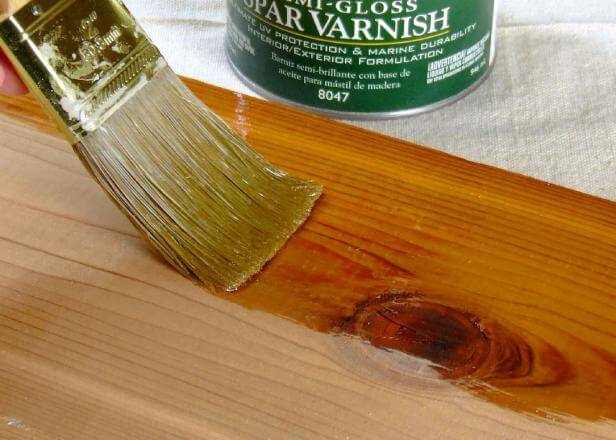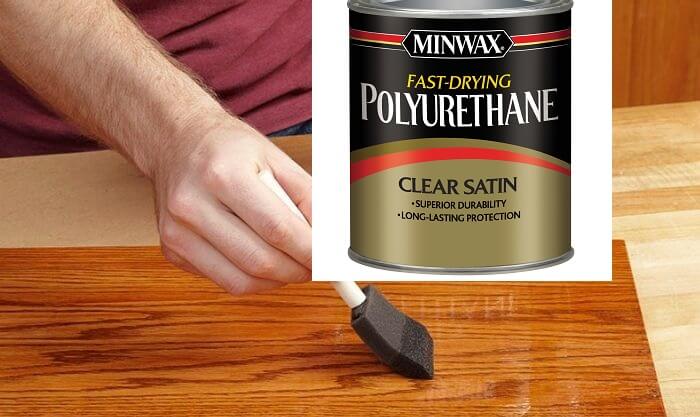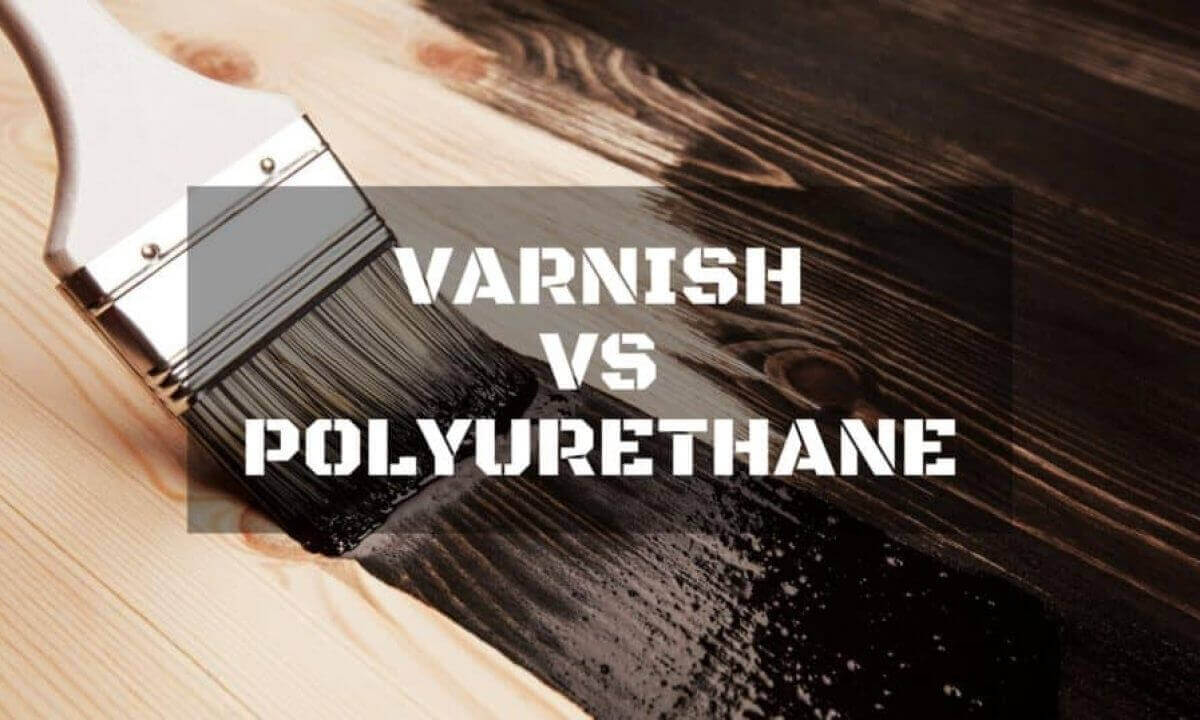Wood finishes protect the wood surface from elements and give your wooden items a lustrous appearance. Additionally, the right finishes enhance the natural characteristics of the wood, including color, grain, and texture.
Unfortunately, picking the right wood finish can be challenging considering the wide variety of choices, from polyurethane to varnish, shellac, lacquer, etc.
We’ve designed this guide to help you choose between the two most common wood finishes – varnish and polyurethane.
Varnish vs Polyurethane: Overview
Varnish consists of resins, oils, and solvents, which make it harder, while polyurethane is water or oil-based plastic resin. The solids in varnish reduce its susceptibility to damage by ultraviolet light. This feature makes varnish a great option for any exterior projects.
Varnish and polyurethane are the two most common wood finishing solutions. They both add a shiny gloss and offer surface protection.
However, they offer different levels of durability and appeal. Above all, they cost differently and are applied differently.
So, which one should you use? Below is a brief overview of each wood finish before we compare them head to head.
What is Varnish?
Varnish is a natural wood finish. It’s the older of the two, having been around for decades and an excellent choice for outdoor applications.
Properties of Wood Varnish
Varnish is a mixture of resin, solvent, and oil. It cures into a thin, glossy film with a faint yellow or amber-tinted color closely resembling an oil-based polyurethane finish.
Wood varnish has a high solids content that makes it highly weather resistant. For instance, it’s highly resistant to UV light and water damage. This makes it ideal for outdoor decks, garden seats, and other backyard furniture.
Varnish is less toxic compared to polyurethane. It’s also more flexible, thus less prone to breaking as the furniture wood expands and shrinks due to weather changes. This makes it a great choice for softwoods.
Varnish coats are extremely thin. Therefore, you need multiple coats to achieve the desired finish. Also, varnish layers work independently, meaning the next coat won’t stick firmly onto the previous layer.
Therefore, you must sand the existing coating or scrap it with steel wool before applying the next coating. Finally, varnish works best on smooth, dry, debris-free surfaces.
Wood Varnish Pros and Cons
Pros
- Varnishes provide excellent protection against UV rays
- Varnish is the best finish for outdoor furniture
- It’s highly abrasion resistant and protects surfaces from water and stains
- Varnish is very easy to apply with a bristled brush
Cons
- Varnish emits toxic VOCs
- It is very slow-drying
- The risk of peeling, cracking, and water bubbles is high
Varnish Uses

Varnish’s high solid content and water resistance make it ideal for water-exposed outdoor decks, deck chairs, and wooden boats. Additionally, varnish’s low toxicity makes it apt for use around entryways, exit doors, and trim.
Meanwhile, a varnish variant known as spar or marine varnish, because of its excellent UV protection and flexibility, is commonly used on softwoods, such as pine, that bend under extreme conditions.
Interesting Post: Wood Varnish Vs Stain
What is Polyurethane?
Polyurethane is made from a plastic resin and dries to a hard plastic layer. It appears milky inside the container but is a clear liquid when applied.
Properties of Polyurethane
Polyurethane finishes are either oil-based or water-based. An oil-based polyurethane finish is more durable than a water-based finish and offers greater surface protection.
Moreover, oil-based polyurethane finishes are thicker and thus require fewer layers than varnish. Water-based polyurethane finishes are durable too, but not like oil-based polyurethane finishes.
For instance, they’re more prone to cracking if exposed to heat or the sun. Therefore, they’re best suited for indoor surfaces. However, water-based polyurethane is less toxic and easier to clean with water and soap.
Therefore, it’s a better choice for people allergic to oil-based polyurethane. Water-based polyurethane is also less expensive than oil-based polyurethane.
Pros and Cons of Polyurethane
Pros
- It’s a strong finish that forms a tough solid layer when dry
- It provides excellent protection against spills, scratches, and abrasion
- It’s the perfect finish for heavily used surfaces, such as wooden floors
- It’s ideal for coastal furniture, exposed to salts
Cons
- Polyurethane yellows when exposed to light
- It cracks after prolonged exposure to UV rays
- It’s very difficult to repair in case of damage
Polyurethane Uses

Water-based polyurethane is ideal for indoor furniture, including nightstands and coat racks. On the other hand, water-based, oil-modified polyurethane is another great choice for indoor woodworking projects.
Meanwhile, oil-based polyurethane is a good choice for intricate wood carvings, kitchen tables, cutting surfaces, and bar tops. Now, find out the best polyurethane for kitchen tables.
Varnish vs Polyurethane: Head to Head
Now we have a basic understanding of polyurethane and varnish. So, how do the two compare? Let’s find out.
Composition: Tied
Varnish comprises resins, solvents, oils, and driers. When applied to a surface, the solvent portion evaporates, and the remaining constituents oxidize, forming a durable, transparent film.
Meanwhile, polyurethane is a category of polymers composed of organic units joined by carbamate links.
Types/Options: Varnish Wins
Wood varnishes offer woodworkers more choices, as there are at least six types of varnish. These are spirit, acrylic, polyurethane, marine varnish (also known as yacht varnish), oil, and alkyd varnish.
Alkyd varnishes, made from alkyd resin, are arguably the most versatile of the six. Meanwhile, polyurethane only offers two options, namely oil-based and water-based. Oil-based varnishes use oil as the solvent, while water varnishes use water.
Durability: Polyurethane Wins
Polyurethane finishes are more durable and harder than varnish finishes. Oil-based polyurethane, in particular, withstands heavy traffic.
It cures into a hard plastic that resists abrasion, scratching, and other forms of abuse. However, it’s susceptible to cracking and UV damage. Varnish is less durable than polyurethane. However, it’s more resistant to cracking and UV damage.
Drying Time: Polyurethane Wins
It’s hard to compare polyurethane and varnish drying times because the duration varies from one varnish or polyurethane type to the next. However, polyurethane is generally faster-drying.
Although some types take up to 24 hours to dry, standard polyurethane finishes are fully dried within two hours. However, water-based polyurethane may take up to 48 hours to cry. On the other hand, varnish takes at least six hours to dry.
If you’re dealing with the issue of polyurethane taking a long time to dry, consider reading our comprehensive article that outlines effective steps to address polyurethane not drying.
Toxicity: Varnish Wins
Both varnish and polyurethane finishes are toxic. For instance, the resins and solvents used in wood varnish are poisonous if ingested. Moreover, most varnishes contain benzene, a carcinogen.
However, polyurethane is even more toxic. It contains isocyanates that emit volatile organic compounds (VOCs) that can trigger numerous health issues. Fortunately, both components are rendered harmless once polyurethane cures in about 30 days.
Also, read our article titled “How Toxic Is Polyurethane?” to discover more about the potential hazards and risks associated with this substance.
Price: Varnish Wins
Polyurethane is generally pricier than wood varnish because it’s more durable. Moreover, polyurethane is a little more complicated to make.
However, the price difference is often small, typically 10% to 20%. Indeed, some varnish brands are more expensive than some polyurethane brands. It depends on the type and brand of finish.
Application process: Polyurethane Wins
Polyurethane is easier to apply than wood varnish. You can easily apply water-based or oil-based polyurethane using a fine-bristled brush, foam roller, or rag.
Alternatively, you can use polyurethane spray. You only need 2-3 coats. However, always use a respirator when applying oil-based polyurethane indoors.
Unfortunately, varnishes aren’t as easy to apply. First, you must thoroughly clean the surface and let it dry completely. Otherwise, the dried varnish can peel, crack, or form bubbled.
Or worse, it may not dry fully. Additionally, you need more coats of varnish for the best finish. Always use a natural bristle brush to apply varnish.
Read also: Can you put water-based polyurethane over varnish?
FAQs
Varnish vs Polyurethane
The difference between varnish and polyurethane is that varnish is made from resins, oils, and solvents, while polyurethane consists of polyol and diisocyanate. A lot of solids in varnish make it less susceptible to UV damage. Polyol and diisocyanate combine to form a stable long-chain molecule, making polyurethane highly susceptible and resistant to harsh environments.
Should you use varnish for hardwood floors?
Yes, you can use varnish for hardwood floors but on particular occasions. Use it if your installed floor is unfinished to protect it from damage. In case your floor has lost its glossiness, you can also use varnish. What’s more, varnish coating is durable and likely to last longer, between five to ten years.
Is varnish the same as polyurethane?
No, varnish is not the same as polyurethane. Varnish is specifically meant for outdoor projects like decks and exterior furniture because it’s less susceptible to ultraviolet light damage. While exterior poly is used outside, interior poly is strictly limited for inside as they lack additives that protect them from UV rays. Also, read our article on the best outdoor polyurethane to use.
What is the best varnish for wood floors?
There is no single answer to the question of what is the best varnish for wood floors. Several factors depend on taste and preference. However, it is important to use a quality varnish, as it will extend the life expectancy of your wooden floor, making it look good for a longer period.
What is the difference between conversion varnish and polyurethane?
The most significant difference between conversion varnish and polyurethane is that conversion varnish requires a hardening agent, while polyurethane is a single-element finish that doesn’t need a hardening agent. Typically, the hardening agent acts as a catalyst accelerating its drying time, unlike polyurethane which takes a longer duration.
Does varnish yellow?
Yes, varnish yellow. The finish cures into a thin and glossy film with a yellow color if you apply it to wooden surfaces inside or outside. This is caused by light and air exposure. However, discoloring is expected as varnishes made from natural resins plus synthetic ones tend to yellow as they age.
Read: Polyurethane vs shellac
Verdict
It’s not easy to separate polyurethane and varnish as both are excellent wood finishes. So, the most important thing is finding the best fit for your project.
- When to Use Varnish: Varnish’s water resistance and high UV protection makes it ideal for decks, deck chairs, and other outdoor applications that don’t experience heavy use.
- When to Use Polyurethane: Polyurethane is the ideal finish for indoor wood surfaces that encounter heavy use. So, it’s perfect for wooden floors, desktops, bar tops, and cutting boards.

